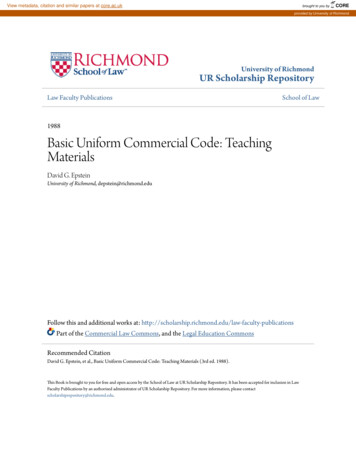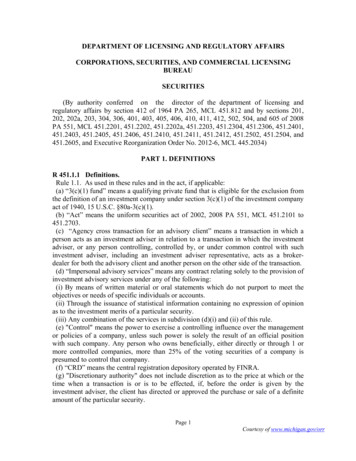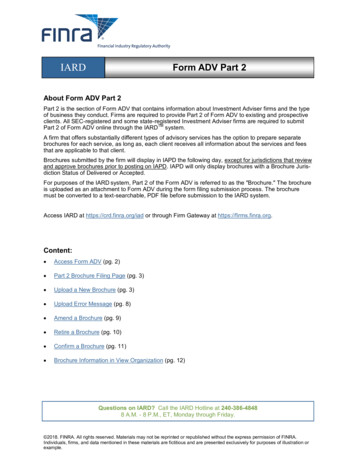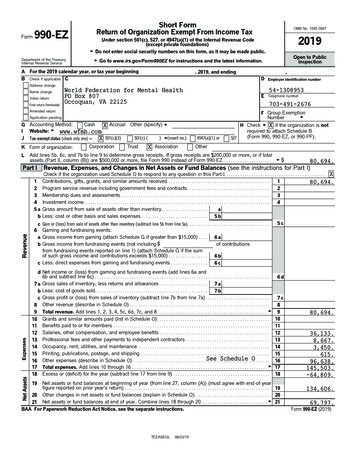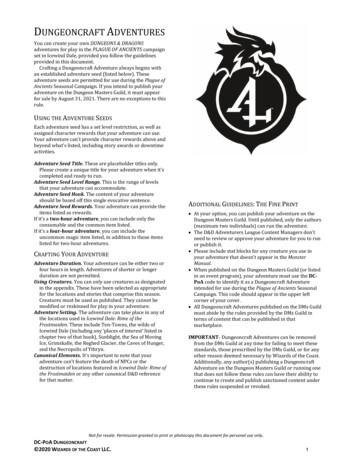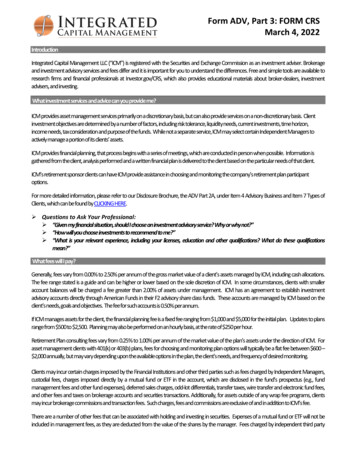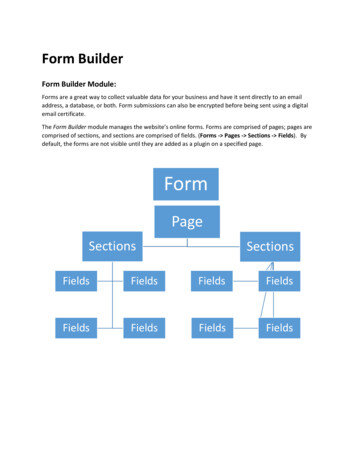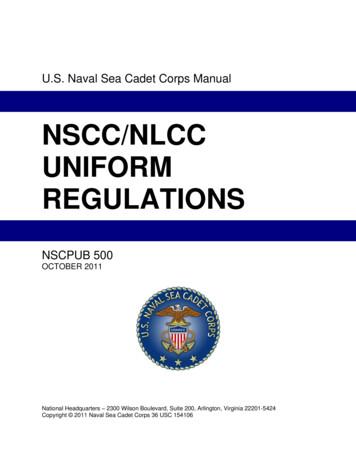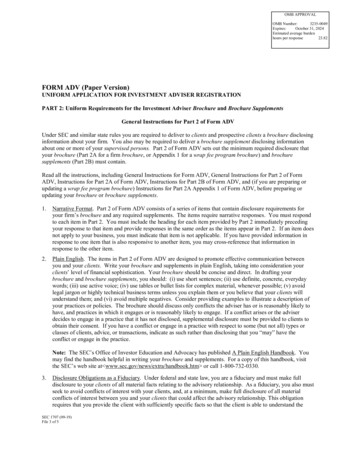
Transcription
OMB APPROVALOMB Number:3235-0049Expires:October 31, 2024Estimated average burdenhours per response23.82FORM ADV (Paper Version)UNIFORM APPLICATION FOR INVESTMENT ADVISER REGISTRATIONPART 2: Uniform Requirements for the Investment Adviser Brochure and Brochure SupplementsGeneral Instructions for Part 2 of Form ADVUnder SEC and similar state rules you are required to deliver to clients and prospective clients a brochure disclosinginformation about your firm. You also may be required to deliver a brochure supplement disclosing informationabout one or more of your supervised persons. Part 2 of Form ADV sets out the minimum required disclosure thatyour brochure (Part 2A for a firm brochure, or Appendix 1 for a wrap fee program brochure) and brochuresupplements (Part 2B) must contain.Read all the instructions, including General Instructions for Form ADV, General Instructions for Part 2 of FormADV, Instructions for Part 2A of Form ADV, Instructions for Part 2B of Form ADV, and (if you are preparing orupdating a wrap fee program brochure) Instructions for Part 2A Appendix 1 of Form ADV, before preparing orupdating your brochure or brochure supplements.1.Narrative Format. Part 2 of Form ADV consists of a series of items that contain disclosure requirements foryour firm’s brochure and any required supplements. The items require narrative responses. You must respondto each item in Part 2. You must include the heading for each item provided by Part 2 immediately precedingyour response to that item and provide responses in the same order as the items appear in Part 2. If an item doesnot apply to your business, you must indicate that item is not applicable. If you have provided information inresponse to one item that is also responsive to another item, you may cross-reference that information inresponse to the other item.2.Plain English. The items in Part 2 of Form ADV are designed to promote effective communication betweenyou and your clients. Write your brochure and supplements in plain English, taking into consideration yourclients’ level of financial sophistication. Your brochure should be concise and direct. In drafting yourbrochure and brochure supplements, you should: (i) use short sentences; (ii) use definite, concrete, everydaywords; (iii) use active voice; (iv) use tables or bullet lists for complex material, whenever possible; (v) avoidlegal jargon or highly technical business terms unless you explain them or you believe that your clients willunderstand them; and (vi) avoid multiple negatives. Consider providing examples to illustrate a description ofyour practices or policies. The brochure should discuss only conflicts the adviser has or is reasonably likely tohave, and practices in which it engages or is reasonably likely to engage. If a conflict arises or the adviserdecides to engage in a practice that it has not disclosed, supplemental disclosure must be provided to clients toobtain their consent. If you have a conflict or engage in a practice with respect to some (but not all) types orclasses of clients, advice, or transactions, indicate as such rather than disclosing that you “may” have theconflict or engage in the practice.Note: The SEC’s Office of Investor Education and Advocacy has published A Plain English Handbook. Youmay find the handbook helpful in writing your brochure and supplements. For a copy of this handbook, visitthe SEC’s web site at www.sec.gov/news/extra/handbook.htm or call 1-800-732-0330.3.Disclosure Obligations as a Fiduciary. Under federal and state law, you are a fiduciary and must make fulldisclosure to your clients of all material facts relating to the advisory relationship. As a fiduciary, you also mustseek to avoid conflicts of interest with your clients, and, at a minimum, make full disclosure of all materialconflicts of interest between you and your clients that could affect the advisory relationship. This obligationrequires that you provide the client with sufficiently specific facts so that the client is able to understand theSEC 1707 (09-19)File 3 of 5
conflicts of interest you have and the business practices in which you engage, and can give informed consent tosuch conflicts or practices or reject them. To satisfy this obligation, you therefore may have to disclose toclients information not specifically required by Part 2 of Form ADV or in more detail than the brochure itemsmight otherwise require. You may disclose this additional information to clients in your brochure or by someother means.4.Full and Truthful Disclosure. All information in your brochure and brochure supplements must be true andmay not omit any material facts.5.Filing. You must file your brochure(s) (and amendments) through the IARD system using the text-searchableAdobe Portable Document Format (“PDF”). See SEC rules 203-1 and 204-1 and similar state rules. If you areregistered or are registering with the SEC, you are not required to file your brochure supplements through theIARD or otherwise. You must, however, preserve a copy of the supplements and make them available to SECstaff upon request. See SEC rule 204-2(a)(14). If you are registered or are registering with one or more statesecurities authorities, you must file a copy of the brochure supplement for each supervised person doingbusiness in that state.
Instructions for Part 2A of Form ADV: Preparing Your Firm Brochure1.To whom must we deliver a firm brochure? You must give a firm brochure to each client. You must deliverthe brochure even if your advisory agreement with the client is oral. See SEC rule 204-3(b) and similar staterules.If you are registered with the SEC, you are not required to deliver your brochure to either (i) clients whoreceive only impersonal investment advice from you and who will pay you less than 500 per year or (ii) clientsthat are SEC-registered investment companies or business development companies (the client must beregistered under the Investment Company Act of 1940 or be a business development company as defined in thatAct, and the advisory contract must meet the requirements of section 15(c) of that Act). See SEC rule 204-3(c).Note: Even if you are not required to give a brochure to a client, as a fiduciary you may still be required toprovide your clients with similar information, particularly material information about your conflicts of interestand about your disciplinary information. If you are not required to give a client a brochure, you may make anyrequired disclosures to that client by delivery of your brochure or through some other means.2.When must we deliver a brochure to clients? You must give a firm brochure to each client before or at the time you enter into an advisory agreement withthat client. See SEC rule 204-3(b) and similar state rules. Each year you must (i) deliver, within 120 days of the end of your fiscal year, to each client a free updatedbrochure that either includes a summary of material changes or is accompanied by a summary of materialchanges, or (ii) deliver to each client a summary of material changes that includes an offer to provide a copyof the updated brochure and information on how a client may obtain the brochure. See SEC rule 204-3(b)and similar state rules. You do not have to deliver an interim amendment to clients unless the amendment includes information inresponse to Item 9 of Part 2A (disciplinary information). An interim amendment can be in the form of adocument describing the material facts relating to the amended disciplinary event. See SEC rule 204-3(b)and similar state rules.Note: As a fiduciary, you have an ongoing obligation to inform your clients of any material information thatcould affect the advisory relationship. As a result, between annual updating amendments you must disclosematerial changes to such information to clients even if those changes do not trigger delivery of an interimamendment. See General Instructions for Part 2 of Form ADV, Instruction 3.3.May we deliver our brochure electronically? Yes. The SEC has published interpretive guidance on deliveringdocuments electronically, which you can find at www.sec.gov/rules/concept/33-7288.txt .4.When must we update our brochure? You must update your brochure: (i) each year at the time you file yourannual updating amendment; and (ii) promptly whenever any information in the brochure becomes materiallyinaccurate. You are not required to update your brochure between annual amendments solely because theamount of client assets you manage has changed or because your fee schedule has changed. However, if youare updating your brochure for a separate reason in between annual amendments, and the amount of clientassets you manage listed in response to Item 4.E or your fee schedule listed in response to Item 5.A has becomematerially inaccurate, you should update that item(s) as part of the interim amendment. All updates to yourbrochure must be filed through the IARD system and maintained in your files. See SEC rules 204-1 and 2042(a)(14) and similar state rules.5.We are filing our annual updating amendment. The last brochure(s) that we filed does not contain anymaterially inaccurate information. Do we have to prepare a summary of material changes? No, as long as you
have not filed any interim amendments making material changes to the brochure that you filed with last year’sannual updating amendment. If you do not have to prepare a summary of material changes, you do not have todeliver a summary of material changes or a brochure to your existing clients that year. See SEC rule 204-3(b).If you are a state-registered adviser, you should contact the appropriate state securities authorities to determinewhether you must make an annual offer of the brochure.6.Do we need to include the summary of material changes that we prepare in response to Item 2 with our annualupdating amendment filing on IARD? Yes, you need to include the summary in your annual updatingamendment. Item 2 permits you to include the summary as part of the brochure (on the cover page or the pageimmediately following the cover page) or to create a separate document containing the summary. If you includethe summary as part of your brochure, the summary will be part of the annual updating amendment filing thatyou submit on IARD. If your summary of material changes is a separate document, you must attach thesummary as an exhibit to your brochure and upload your brochure and the summary together in a single, textsearchable file in Adobe Portable Document Format on IARD for your annual updating amendment.Note: If you include the summary of material changes in your brochure, and you revise or update yourbrochure between annual updating amendments, you should consider whether you should update the summaryas part of that other-than annual amendment to avoid confusing or misleading clients reading the updatedbrochure.7.We have determined that we have no clients to whom we must deliver a brochure. Must we prepare one? No,but see note to Instruction 1 above.8.May we include a summary of the brochure at the beginning of our brochure? Yes. Although it is notrequired, you may choose to include a summary of the brochure at the beginning of your brochure. Suchsummary, however, may not substitute for the summary of material changes required by Item 2 of Part 2A.9.We offer several advisory services. May we prepare multiple firm brochures? Yes. If you offer substantiallydifferent types of advisory services, you may opt to prepare separate brochures so long as each client receivesall applicable information about services and fees. Each brochure may omit information that does not apply tothe advisory services and fees it describes. For example, your firm brochure sent to your clients who investonly in the United States can omit information about your advisory services and fees relating to offshoreinvestments. See SEC rule 204-3(e) and similar state rules. If you prepare separate brochures you must fileeach brochure (and any amendments) through the IARD system as required in SEC rules 203-1 and 204-1 andsimilar state rules.10. We sponsor a wrap fee program. Is there a different brochure that we need to deliver to our wrap fee clients?Yes. If you sponsor a wrap fee program, you must deliver a wrap fee program brochure to your wrap feeclients. The disclosure requirements for preparing a wrap fee program brochure appear in Part 2A, Appendix 1of Form ADV. If your entire advisory business is sponsoring wrap fee programs, you do not need to prepare afirm brochure separate from your wrap fee program brochure(s). See SEC rule 204-3(d) and similar state rules.11. We provide portfolio management services to clients in wrap fee programs that we do not sponsor. Whichbrochure must we deliver to these clients? You must deliver your brochure prepared in accordance with Part2A (not Appendix 1) to your wrap fee clients. You also must deliver to these clients any brochure supplementsrequired by Part 2B of Form ADV.12. May we include information not required by an item in our brochure? Yes. If you include information notrequired by an item, however, you may not include so much additional information that the requiredinformation is obscured.13. Item 18 requires us to give our clients an audited balance sheet. May any public accountant perform the audit?Your auditor must be independent. Article 2 of SEC Regulation S-X sets out the general rules for auditor
independence. Please note that these requirements may be different from the rules of professionalorganizations.14. We are a new firm. Do we need a brochure? Yes. Respond to items in Part 2A of Form ADV based on theadvisory services you propose to provide and the practices, policies and procedures you propose to adopt.15. We are a “separately identifiable department or division” (SID) of a bank. Must our brochure discuss ourbank’s general business practices? No. Information you include in your firm brochure (or in brochuresupplements) should be information about you, the SID, and your business practices, rather than generalinformation about your bank.
Part 2A of Form ADV: Firm BrochureItem 1Cover PageA. The cover page of your brochure must state your name, business address, contact information, websiteaddress (if you have one), and the date of the brochure.Note: If you primarily conduct advisory business under a name different from your full legal name, andyou have disclosed your business name in Item 1.B of Part 1A of Form ADV, then you may use yourbusiness name throughout your brochure.B. Display on the cover page of your brochure the following statement or other clear and concise languageconveying the same information, and identifying the document as a “brochure”:This brochure provides information about the qualifications and business practices of [your name].If you have any questions about the contents of this brochure, please contact us at [telephone numberand/or email address]. The information in this brochure has not been approved or verified by theUnited States Securities and Exchange Commission or by any state securities authority.Additional information about [your name] also is available on the SEC’s website atwww.adviserinfo.sec.gov.C. If you refer to yourself as a “registered investment adviser” or describe yourself as being “registered,”include a statement that registration does not imply a certain level of skill or training.Item 2Material ChangesIf you are amending your brochure for your annual update and it contains material changes from your last annualupdate, identify and discuss those changes on the cover page of the brochure or on the page immediately followingthe cover page, or as a separate document accompanying the brochure. You must state clearly that you arediscussing only material changes since the last annual update of your brochure, and you must provide the date of thelast annual update of your brochure.Note:Item 3You do not have to separately provide this information to a client or prospective client who has notreceived a previous version of your brochure.Table of ContentsProvide a table of contents to your brochure.Note: Your table of contents must be detailed enough so that your clients can locate topics easily. Your brochuremust follow the same order, and contain the same headings, as the items listed in Part 2A.Item 4Advisory BusinessA. Describe your advisory firm, including how long you have been in business. Identify your principalowner(s).Notes: (1) For purposes of this item, your principal owners include the persons you list as owning 25% ormore of your firm on Schedule A of Part 1A of Form ADV (Ownership Codes C, D or E). (2) If you are apublicly held company without a 25% shareholder, simply disclose that you are publicly held. (3) If anindividual or company owns 25% or more of your firm through subsidiaries, you must identify theindividual or parent company and intermediate subsidiaries. If you are an SEC-registered adviser, you
must identify intermediate subsidiaries that are publicly held, but not other intermediate subsidiaries. If youare a state-registered adviser, you must identify all intermediate subsidiaries.B. Describe the types of advisory services you offer. If you hold yourself out as specializing in a particulartype of advisory service, such as financial planning, quantitative analysis, or market timing, explain thenature of that service in greater detail. If you provide investment advice only with respect to limited typesof investments, explain the type of investment advice you offer, and disclose that your advice is limited tothose types of investments.C. Explain whether (and, if so, how) you tailor your advisory services to the individual needs of clients.Explain whether clients may impose restrictions on investing in certain securities or types of securities.D. If you participate in wrap fee programs by providing portfolio management services, (1) describe thedifferences, if any, between how you manage wrap fee accounts and how you manage other accounts, and(2) explain that you receive a portion of the wrap fee for your services.E. If you manage client assets, disclose the amount of client assets you manage on a discretionary basis andthe amount of client assets you manage on a non-discretionary basis. Disclose the date “as of” which youcalculated the amounts.Note: Your method for computing the amount of “client assets you manage” can be different from the methodfor computing “regulatory assets under management” required for Item 5.F in Part 1A. However, if you chooseto use a different method to compute “client assets you manage,” you must keep documentation describing themethod you use. The amount you disclose may be rounded to the nearest 100,000. Your “as of” date must notbe more than 90 days before the date you last updated your brochure in response to this Item 4.E.Item 5Fees and CompensationA. Describe how you are compensated for your advisory services. Provide your fee schedule. Disclosewhether the fees are negotiable.Note: If you are an SEC-registered adviser, you do not need to include this information in a brochure that isdelivered only to qualified purchasers as defined in section 2(a)(51)(A) of the Investment Company Act of1940.B. Describe whether you deduct fees from clients’ assets or bill clients for fees incurred. If clients may selecteither method, disclose this fact. Explain how often you bill clients or deduct your fees.C. Describe any other types of fees or expenses clients may pay in connection with your advisory services,such as custodian fees or mutual fund expenses. Disclose that clients will incur brokerage and othertransaction costs, and direct clients to the section(s) of your brochure that discuss brokerage.D. If your clients either may or must pay your fees in advance, disclose this fact. Explain how a client mayobtain a refund of a pre-paid fee if the advisory contract is terminated before the end of the billing period.Explain how you will determine the amount of the refund.E. If you or any of your supervised persons accepts compensation for the sale of securities or other investmentproducts, including asset-based sales charges or service fees from the sale of mutual funds, disclose thisfact and respond to Items 5.E.1, 5.E.2, 5.E.3 and 5.E.4.1.Explain that this practice presents a conflict of interest and gives you or your supervised persons anincentive to recommend investment products based on the compensation received, rather than on aclient’s needs. Describe generally how you address conflicts that arise, including your procedures for
disclosing the conflicts to clients. If you primarily recommend mutual funds, disclose whether youwill recommend “no-load” funds.2.Explain that clients have the option to purchase investment products that you recommend throughother brokers or agents that are not affiliated with you.3.If more than 50% of your revenue from advisory clients results from commissions and othercompensation for the sale of investment products you recommend to your clients, including assetbased distribution fees from the sale of mutual funds, disclose that commissions provide your primaryor, if applicable, your exclusive compensation.4.If you charge advisory fees in addition to commissions or markups, disclose whether you reduce youradvisory fees to offset the commissions or markups.Note: If you receive compensation in connection with the purchase or sale of securities, you shouldcarefully consider the applicability of the broker-dealer registration requirements of the SecuritiesExchange Act of 1934 and any applicable state securities statutes.Item 6Performance-Based Fees and Side-By-Side ManagementIf you or any of your supervised persons accepts performance-based fees – that is, fees based on a share of capitalgains on or capital appreciation of the assets of a client (such as a client that is a hedge fund or other pooledinvestment vehicle) – disclose this fact. If you or any of your supervised persons manage both accounts that arecharged a performance-based fee and accounts that are charged another type of fee, such as an hourly or flat fee oran asset-based fee, disclose this fact. Explain the conflicts of interest that you or your supervised persons face bymanaging these accounts at the same time, including that you or your supervised persons have an incentive to favoraccounts for which you or your supervised persons receive a performance-based fee, and describe generally howyou address these conflicts.Item 7Types of ClientsDescribe the types of clients to whom you generally provide investment advice, such as individuals, trusts,investment companies, or pension plans. If you have any requirements for opening or maintaining an account, suchas a minimum account size, disclose the requirements.Item 8Methods of Analysis, Investment Strategies and Risk of LossA. Describe the methods of analysis and investment strategies you use in formulating investment advice ormanaging assets. Explain that investing in securities involves risk of loss that clients should be prepared tobear.B. For each significant investment strategy or method of analysis you use, explain the material risks involved.If the method of analysis or strategy involves significant or unusual risks, discuss these risks in detail. Ifyour primary strategy involves frequent trading of securities, explain how frequent trading can affectinvestment performance, particularly through increased brokerage and other transaction costs and taxes.C. If you recommend primarily a particular type of security, explain the material risks involved. If the type ofsecurity involves significant or unusual risks, discuss these risks in detail.
Item 9Disciplinary InformationIf there are legal or disciplinary events that are material to a client’s or prospective client’s evaluation of youradvisory business or the integrity of your management, disclose all material facts regarding those events.Items 9.A, 9.B, and 9.C list specific legal and disciplinary events presumed to be material for this Item. If youradvisory firm or a management person has been involved in one of these events, you must disclose it under thisItem for ten years following the date of the event, unless (1) the event was resolved in your or the managementperson’s favor, or was reversed, suspended or vacated, or (2) you have rebutted the presumption of materialityto determine that the event is not material (see Note below). For purposes of calculating this ten-year period,the “date” of an event is the date that the final order, judgment, or decree was entered, or the date that any rightsof appeal from preliminary orders, judgments or decrees lapsed.Items 9.A, 9.B, and 9.C do not contain an exclusive list of material disciplinary events. If your advisory firm ora management person has been involved in a legal or disciplinary event that is not listed in Items 9.A, 9.B, or9.C, but nonetheless is material to a client's or prospective client's evaluation of your advisory business or theintegrity of its management, you must disclose the event. Similarly, even if more than ten years have passedsince the date of the event, you must disclose the event if it is so serious that it remains material to a client’s orprospective client’s evaluation.A. A criminal or civil action in a domestic, foreign or military court of competent jurisdiction in which yourfirm or a management person1.was convicted of, or pled guilty or nolo contendere (“no contest”) to (a) any felony; (b) a misdemeanorthat involved investments or an investment-related business, fraud, false statements or omissions,wrongful taking of property, bribery, perjury, forgery, counterfeiting, or extortion; or (c) a conspiracyto commit any of these offenses;2.is the named subject of a pending criminal proceeding that involves an investment-related business,fraud, false statements or omissions, wrongful taking of property, bribery, perjury, forgery,counterfeiting, extortion, or a conspiracy to commit any of these offenses;3.was found to have been involved in a violation of an investment-related statute or regulation; or4.was the subject of any order, judgment, or decree permanently or temporarily enjoining, or otherwiselimiting, your firm or a management person from engaging in any investment-related activity, or fromviolating any investment-related statute, rule, or order.B. An administrative proceeding before the SEC, any other federal regulatory agency, any state regulatoryagency, or any foreign financial regulatory authority in which your firm or a management person1.was found to have caused an investment-related business to lose its authorization to do business; or2.was found to have been involved in a violation of an investment-related statute or regulation and wasthe subject of an order by the agency or authority(a) denying, suspending, or revoking the authorization of your firm or a management person to act inan investment-related business;(b) barring or suspending your firm’s or a management person's association with an investmentrelated business;(c) otherwise significantly limiting your firm’s or a management person's investment-relatedactivities; or
(d) imposing a civil money penalty of more than 2,500 on your firm or a management person.C. A self-regulatory organization (SRO) proceeding in which your firm or a management person1.was found to have caused an investment-related business to lose its authorization to do business; or2.was found to have been involved in a violation of the SRO’s rules and was: (i) barred or suspendedfrom membership or from association with other members, or was expelled from membership;(ii) otherwise significantly limited from investment-related activities; or (iii) fined more than 2,500.Note: You may, under certain circumstances, rebut the presumption that a disciplinary event is material. If anevent is immaterial, you are not required to disclose it. When you review a legal or disciplinary event involvingyour firm or a management person to determine whether it is appropriate to rebut the presumption ofmateriality, you should consider all of the following factors: (1) the proximity of the person involved in thedisciplinary event to the advisory function; (2) the nature of the infraction that led to the disciplinary event; (3)the severity of the disciplinary sanction; and (4) the time elapsed since the date of the disciplinary event. If youconclude that the materiality presumption has been overcome, you must prepare and maintain a filememorandum of your determination in your records. See SEC rule 204-2(a)(14)(iii).Item 10Other Financial Industry Activities and AffiliationsA. If you or any of your management persons are registered, or have an application pending to register, as abroker-dealer or a registered representative of a broker-dealer, disclose this fact.B. If you or any of your management persons are registered, or have an application pending to register, as afutures commission merchant, commodity pool operator, a commodity trading advisor, or an associatedperson of the foregoing entities, disclose this fact.C. Describe any relationship or arrangement that is material to your advisory business or to your clients thatyou or any of your management persons have with any related person listed below. Identify the relatedperson and if the relationship or arrangement creates a material conflict of interest with clients, describe thenature of the conflict and how you address it.1.2.broker-dealer, municipal securities dealer, or government securities dealer or brokerinvestment company or other pooled investment vehicle (including a mutual fund, closed-endinvestment company, unit investment trust, private investment company or “hedge fund,” and offshorefund)3. other investment adviser or financial planner4. futures commission merchant, commodity pool operator, or commodity trading advisor5. banking or thrift institution6. accountant or accounting fir
Instructions for Part 2A of Form ADV: Preparing Your Firm Brochure. 1. To whom must we deliver a firm brochure?You must give a firm brochure to each client.You must deliver the brochure even if your advisory agreement with the client is oral. See SEC rule 204-3(b) and similar state

